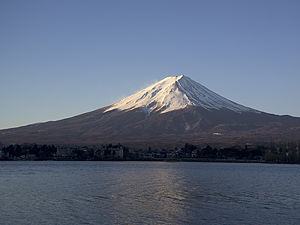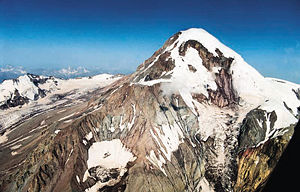Stratovolcano

A stratovolcano, also called a composite volcano, is a tall, conical volcano composed of many layers (strata) of hardened lava, tephra, and volcanic ash. Such volcanoes are characterized by a steep profile and periodic, explosive eruptions. The lava that flows from them is viscous; it cools and hardens before spreading far. The magma forming this lava is classified as felsic, having high to intermediate levels of silica (as in rhyolite, dacite, or andesite), unlike less viscous mafic magma, which forms shield volcanoes (such as Mauna Loa in Hawaii), having wider bases and more gently sloping profiles.
Although stratovolcanoes are sometimes called composite volcanoes, volcanologists prefer stratovolcano because many other volcanoes have a composite (layered) structure — they are built up from sequential outpourings of eruptive materials. Stratovolcanoes are one of the most common types of volcanoes.
Contents |
Information

Stratovolcanoes are common in subduction zones, forming chains or 'arcs' along tectonic plate boundaries where oceanic crust is drawn under continental crust (Continental Arc Volcanism, e.g. Cascade Range, central Andes) or another oceanic plate (Island arc Volcanism, e.g. Japan, Aleutian Islands). The magma that forms stratovolcanoes rises when water, which is trapped, both in hydrated minerals and in the porous basalt rock of the upper oceanic crust, is released into mantle rock of the asthenosphere above the sinking oceanic slab. The release of water from hydrated minerals is termed "dewatering," and occurs at specific pressures and temperatures for each mineral, as the plate descends to greater depths. The water freed from the rock lowers the melting point of the overlying mantle rock, which then undergoes partial melting and rises due to its lighter density relative to the surrounding mantle rock, and pools temporarily at the base of the lithosphere. The magma then rises through the crust, incorporating silica-rich crustal rock, leading to a final intermediate composition. When the magma nears the surface, it pools in a magma chamber under the volcano. There, the relatively low pressure allows water and other volatiles (CO2, S2-, Cl-) dissolved in the magma to escape from solution, as occurs when a bottle of carbonated water is opened. Once a critical volume of magma and gas accumulates, the obstacle provided by the volcanic cone is overcome, leading to a sudden explosive eruption.
Hazards

In recorded history, explosive eruptions at subduction zone (convergent-boundary) volcanoes have posed the greatest hazard to civilizations.[1] Subduction-zone stratovolcanoes like Mount St. Helens and Mount Pinatubo typically erupt with explosive force, because the magma is too stiff to allow easy escape of volcanic gases. As a consequence, tremendous internal pressures mount as the trapped gases expand during ascent, before the pent-up pressure is suddenly released in a violent eruption. Such an explosive process can be compared to putting your thumb over an opened bottle of a carbonated drink, shaking it vigorously, and then quickly removing the thumb. The shaking action separates the gases from the liquid to form bubbles, increasing the internal pressure. Quick release of the thumb allows the gases and liquid to gush out with explosive speed and force.[1]
As examples of the hazards of stratovolcanoes, consider two volcanoes on the western edge of the Philippine Plate that erupted in 1991. On June 15, Mount Pinatubo spewed ash 40 km into the air and produced huge pyroclastic flows and mudflows that devastated a large area around the volcano. Pinatubo, located 90 km from Manila, had been dormant for 600 years before the 1991 eruption, which ranks as one of the largest eruptions in the 20th Century.[1] Also in 1991, Japan's Unzen Volcano, located on the island of Kyushu about 40 km east of Nagasaki, awakened from its 200-year slumber to produce a new lava dome at its summit. Beginning in June, repeated collapses of this active dome generated destructive ash flows that swept down its slopes at speeds as high as 200 km per hour. Unzen is one of more than 75 active volcanoes in Japan; its eruption in 1792 killed more than 15,000 people--the worst volcanic disaster in the country's history.[1]

While the Unzen eruptions have caused deaths and considerable local damage, the impact of the June 1991 eruption of Mount Pinatubo was global. Slightly cooler than usual temperatures recorded worldwide and the brilliant sunsets and sunrises have been attributed to this eruption that sent fine ash and gases high into the stratosphere, forming a large volcanic cloud that drifted around the world. The sulfur dioxide (SO2) in this cloud -- about 22 million tons -- combined with water to form droplets of sulfuric acid, blocking some of the sunlight from reaching the Earth and thereby cooling temperatures in some regions by as much as 0.5 °C.[1] An eruption the size of Mount Pinatubo could affect the weather for a few years; material ejected only into the troposphere will be washed away by rain and winds. A similar phenomenon occurred in April 1815 with the cataclysmic eruption of Tambora Volcano on Sumbawa Island in Indonesia, the most powerful eruption in recorded history. Tambora's volcanic cloud lowered global temperatures by as much as 3 °C.[1] Even a year after the eruption, most of the northern hemisphere experienced sharply cooler temperatures during the summer months. In part of Europe and in North America, 1816 was known as the year without a summer.

Apart from possibly affecting climate, volcanic clouds from explosive eruptions also pose a hazard to aviation safety.[1] This was brought to attention during the 1982 eruption of Galunggung in Java; two Boeing 747 flew into the ash cloud, suffering temporary engine failure and structural damage. During the past two decades, more than 60 airplanes, mostly commercial jetliners, have been damaged by in-flight encounters with volcanic ash. Some of these encounters have resulted in the power loss of all engines, necessitating emergency landings. Luckily, to date no crashes have happened because of jet aircraft flying into volcanic ash.[1]
Since the year A.D. 1600, nearly 300,000 people have been killed by volcanic eruptions.[1] Most deaths were caused by pyroclastic flows and mudflows, deadly hazards which often accompany explosive eruptions of subduction-zone stratovolcanoes. Pyroclastic flows are fast-moving, avalanche-like, ground-hugging incandescent mixtures of hot volcanic debris, ash, and gases that can travel at speeds in excess of 150 km per hour. Approximately 30,000 people were killed by pyroclastic flows during the 1902 eruption of Mont Pelée on the island of Martinique in the Caribbean.[1] In March-April 1982, three explosive eruptions of El Chichón Volcano in the State of Chiapas, southeastern Mexico, caused the worst volcanic disaster in that country's history. Villages within 8 km of the volcano were destroyed by pyroclastic flows, killing more than 2,000 people.[1]
Mudflows (also called debris flows or lahars, an Indonesian term for volcanic mudflows) are mixtures of volcanic debris and water. The water usually comes from two sources: rainfall or the melting of snow and ice by hot volcanic debris. Depending on the proportion of water to volcanic material, mudflows can range from soupy floods to thick flows that have the consistency of wet cement.[1] As mudflows sweep down the steep sides of composite volcanoes, they have the strength and speed to flatten or bury everything in their paths. Hot ash and pyroclastic flows from the eruption of the Nevado del Ruiz Volcano in Colombia, South America, melted snow and ice atop the 5,390-m-high Andean peak; the ensuing mudflows buried the city of Armero, killing 25,000 people.[1] Ashfall is a threat to health when inhaled, and is also a threat to property with high enough accumulation. Greater than 30 cm (1 ft) of accumulation is sufficient to collapse most buildings. Lava flows are generally not a viable threat because generally lava will move slowly enough to allow people to move away; thus they are more of a property threat. However, Nyiragongo is dangerous because of its lava flows; its magma has extremely low silica content, making it more fluid than normal (even when comparing to Hawaiian lava) and thus less viscous. This is compounded by the extremely steep slope of Nyiragongo.

See also
- List of stratovolcanoes
